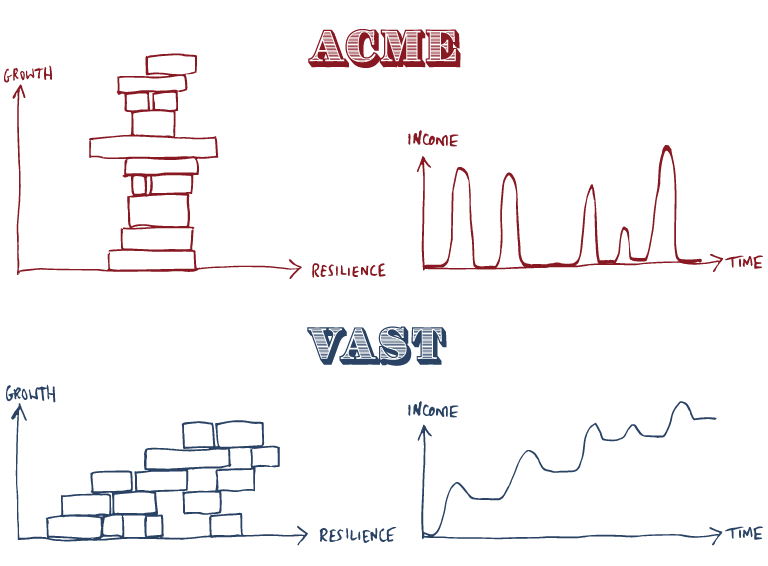Having spent a decent portion of my career building client sites, one thing that always struck me as dangerous was the unsustainable cycle that web agencies tend to fall into. Chasing the next big project, rather than producing the best quality work, often becomes the primary objective of stakeholders. Avoiding this trap is possible by focusing on “horizontal” growth and one way to do this is by leveraging plugins.

Any time a web agency expands its design and development team with the goal of taking on larger projects, it must subsequently continue finding large projects to fill the pipeline with enough work to sustain its larger team (and its payroll). If projects are seen as one-time events that come and go then this can lead to a vicious cycle of unsustainable growth and eventual downsizing.
The solution to healthy and sustained growth is “horizontal” growth. By this, I mean an expansion of service offerings and dedication to customer satisfaction and lasting relationships. This is opposed to “vertical” growth which is the act of stacking more and more of the same type of projects on top of each other, resulting in a Jenga-like tower that is prone to toppling over in times of economic turmoil.
In the illustration above, web agency ACME churns out client sites one after the other, profiting from efficiency, quantity and high output. Web agency VAST, on the other hand, looks for projects that are a good long-term fit and that span multiple service offerings, focusing on high-quality work and profiting from client loyalty and return business.
ACME’s income stream consists of peaks and troughs. Income is unpredictable and depends on a sales funnel that is vulnerable to slow periods in which work dries up and fixed costs exceed income. VAST’s income stream is more gradual but consistent and compounds over time, reducing pressure on the sales teams and human resources.
If you offer this kind of work then you will likely find yourself somewhere in between these two extremes. One way to expand your horizontal offering is by leveraging Craft CMS plugins and the functionality they provide for client sites.
Below are a few examples of “add-on packages” that could be offered to a client seeking a basic website build. Each package would have a one-time setup cost as well as a monthly maintenance cost that clients could cancel at any time. Some plugins and services are also suggested for your internal use – what you use and how you decide to package these is entirely up to you.
Performance Package #
- Site served by a global content delivery network (CDN) for improved load times, reduced bandwidth costs and increased content availability and redundancy.
Cloudflare CDN - Static page caching for extremely fast page load times and reduced server load.
Blitz plugin - Optimised responsive image transforms and offsite image processing for maximum efficiency.
ImageOptimize plugin; imgix
Recoverability & Security Package #
- Daily offsite backups so that if the server crashes or is hacked, it can be brought back online and reverted to its last working state.
Remote Backup plugin - Security and uptime monitoring to notify of any security related issues or downtime.
Sherlock plugin; Oh Dear app & plugin - Monthly updates to the server operating system, Craft CMS and all plugins.
Craft Report app & plugin
SEO & Accessibility Package #
- Site fully optimised for search engines and site crawlers.
SEOmatic plugin - Redirected URLs monitored to ensure no SEO penalties, especially after a site migration.
Retour plugin - Site pages integrated with Accelerated Mobile Pages (AMP) for more customised search engine results (especially for content publishers).
AMP framework - Site conforms to web accessibility standards and guidelines (WCAG).
Web Content Accessibility Guidelines (WCAG)
Email Marketing Package #
- Email marketing fully integrated with Craft CMS.
Campaign plugin - Custom designed email templates for each email campaign type.
MJML framework
Your Secret Sauce Package #
The packages above are only suggestions and the moral of this story is that you can mix and match plugins, apps and services to offer just about any package that you can imagine.
So the next time you are approached to build a site, take the time to do some extra discovery about the client and what could be useful to them. Break apart the process of reaching their end goal, educate them and most importantly listen to them. Be a partner rather than a vendor.

